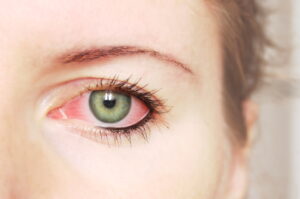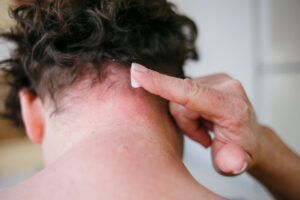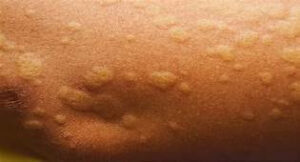
Most of the cases of keratoconjunctivitis and conjunctivitis are due to allergies. Conjunctivitis due to allergies is referred to as allergic conjunctivitis. Infections are another common cause of keratoconjunctivitis and conjunctivitis with viruses accounting for most of the infections across all age groups. Of note, conjunctivitis caused by bacteria is more common in children. Other infectious agents may include a parasite or a fungus. It should also be noted that an injury to the eye can inflame the cornea or conjunctiva without a secondary infection.
Types of Keratoconjunctivitis:
Keratoconjunctivitis sicca is also commonly known as dry eye syndrome. Dry eye occurs when either the eye does not produce enough tears or when the tears evaporate too quickly. It can also occur when there is an imbalance in the tear mixture. Tears are comprised of water, fatty oils, and mucus. Individuals need the correct mixture of all three of these ingredients in order to properly nourish one’s eyes. Some of the more common causes may include allergies, contact lens use, pregnancy, meibomian gland (i.e., glands in eyelids that excrete oil into the tears) dysfunction, and certain medications such as (e.g., antihistamines, some blood pressure medications, hormone replacement therapy, antidepressants).
Epidemic keratoconjunctivitis (EKC) is an eye infection caused by a specific virus called the human adenovirus. It is also known as “adenoviral keratoconjunctivitis” or just “viral keratoconjunctivitis.”
The incubation period of EKC is long and it is very contagious. It tends to spread quite easily especially when individuals are in close quarters (e.g., dormitories, hospitals, schools, arenas, movie theaters).
There’s no specific treatment for EKC. Symptoms typically last a few weeks in duration before abating. Adenoviruses may also target the digestive, respiratory, and genitourinary tracts.
Vernal keratoconjunctivitis (VKC) is a recurrent, chronic allergic inflammation of the eyes. It generally results in small, round bumps known as giant papillae underneath the eyelid. VKC generally affects the upper eyelids more than the lower eyelids. The symptoms are much more common in the Spring with the arrival of pollen, particularly tree and/or grass pollen.
The cause is thought to be an allergic disorder, but may also involve genetic and/or immune system disorders. It is more common in tropical environments and is more common in boys than in girls.
Atopic keratoconjunctivitis (AKC) is a chronic inflammatory disease of the eye that usually affects patients with a history of atopic dermatitis (i.e., eczema). Males are affected with AKC more often than females, and it is more likely to involve the lower eyelids more than the upper eyelids.
Symptoms characteristically worsen in the Winters. Without treatment, AKC may lead to serious complications such as:
- Ulceration
- Keratoconus (i.e., thinning and bulging cornea)
- Corneal vascularization (i.e., growth of new blood vessels into the cornea
Herpetic keratoconjunctivitis is an infection caused by the herpes simplex virus, particularly Type 1. Touching one’s eyes after touching a cold sore may transfer the virus to the eyes.
Allergic keratoconjunctivitis refers to any keratoconjunctivitis caused by an allergen. Vernal keratoconjunctivitis and atopic keratoconjunctivitis, for example, are included in this group. The allergies can be seasonal or perennial in nature.
Symptoms of Keratoconjunctivitis:
Symptoms range from mild to severe. The symptoms may vary depending on the cause. Some symptoms associated with keratoconjunctivitis may include:
- Redness
- Itchiness/Burning
- Puffy eyelids
- Discharge from the eyes (i.e., watery eyes)
- Stickiness of the eyes (i.e., eyes become “glued shut”)
- Light sensitivity (i.e., photophobia)
- Dryness
- “Foreign body” sensation in the eyes
- Blurry of vision (usually mild)
Diagnosis of Keratoconjunctivitis:
The diagnosis can be made based on the medical history, symptoms, and visual inspection of the eyes. Depending on the initial findings, a physician may also want to examine:
- Visual acuity
- Under the eyelids
- Ocular pressure
- Pupillary reactions
- Discharge of the eyes
- Corneal sensation
In some cases, one may need to be tested for:
- Allergens
- Viruses
- Autoimmune disorders
- Genetic conditions
Treatment of Keratoconjunctivitis:
Treating the symptoms:
One may need a combination of therapies which may include:
- Topical antihistamines or mast cell stabilizers
- Preservative-free lubricating gels and ointments
- Nonsteroidal anti-inflammatory drugs (NSAIDs)
- Topical corticosteroids
In cases of severe keratoconjunctivitis sicca, punctal plugs may be inserted to reduce the drainage of the tears into the nose.
Treating the underlying condition(s):
Some viral infections, such as herpes, may require treatment with topical or oral antiviral medications. Any underlying autoimmune or genetic conditions may also need specific treatments.
Black & Kletz Allergy has board certified allergists in 3 convenient locations in the greater Washington, DC, Northern Virginia, and Maryland metropolitan area. The allergists are trained and very familiar with allergic eye disorders such as mentioned above. The allergy specialists at Black & Kletz Allergy diagnose and treat both adults and children. We offer on-site parking in our Washington, DC, McLean, VA (Tysons Corner, VA), and Manassas, VA locations. The Washington, DC and McLean, VA offices are Metro accessible and the McLean office has a free shuttle that runs between the McLean office and the Spring Hill metro station on the silver line. If you are experiencing what appears to be allergy symptoms associated with your eyes, please call us to schedule an appointment. Alternatively, you can click Request an Appointment and we will respond within 24 hours by the next business day. Black & Kletz Allergy has been serving the needs of allergy and asthma sufferers in the Washington, DC metro area for more than 5 decades.


 What are some of the causes?
What are some of the causes? Twenty percent of the U.S population have cat allergies and 10% of the population have dog allergies. In the U.S., the most common pet are dogs, which are followed by cats as the second most common pet. Approximately 70% of homes having at least one pet. This is a higher percentage of homes with pets than in the past as more and more families are acquiring pets. In addition to cats and dogs, some other common pets include birds (e.g., parakeets, parrots), fish, rabbits, rodents (e.g., guinea pigs, hamsters, gerbils, chinchillas, rats, mice) reptiles (e.g., snakes, lizards, turtles, geckos), hermit crabs, ferrets, horses, and spiders. Horses normally do not live in people’s homes, but they may be rather allergenic. In recent years, there is a fad of owning miniature horses which in some cases do live in their owner’s house. This is probably not a good idea in general, but for those who are allergic to horses, it is especially unwise.
Twenty percent of the U.S population have cat allergies and 10% of the population have dog allergies. In the U.S., the most common pet are dogs, which are followed by cats as the second most common pet. Approximately 70% of homes having at least one pet. This is a higher percentage of homes with pets than in the past as more and more families are acquiring pets. In addition to cats and dogs, some other common pets include birds (e.g., parakeets, parrots), fish, rabbits, rodents (e.g., guinea pigs, hamsters, gerbils, chinchillas, rats, mice) reptiles (e.g., snakes, lizards, turtles, geckos), hermit crabs, ferrets, horses, and spiders. Horses normally do not live in people’s homes, but they may be rather allergenic. In recent years, there is a fad of owning miniature horses which in some cases do live in their owner’s house. This is probably not a good idea in general, but for those who are allergic to horses, it is especially unwise. As we are in the Fall season and approaching Winter, many individuals may experience a clear runny nose, post-nasal drip, sneezing, sore throat, nasal congestion, sinus pressure, headache, coughing, and/or fatigue. The question to many becomes, “Do I have a common cold or do I have Fall/Winter allergies? It is a common question to an even more common complaint. How does someone know if they are having allergies rather than the common cold? Well, if someone does not have a history of
As we are in the Fall season and approaching Winter, many individuals may experience a clear runny nose, post-nasal drip, sneezing, sore throat, nasal congestion, sinus pressure, headache, coughing, and/or fatigue. The question to many becomes, “Do I have a common cold or do I have Fall/Winter allergies? It is a common question to an even more common complaint. How does someone know if they are having allergies rather than the common cold? Well, if someone does not have a history of  A mast cell is a component of the immune system that is involved in the allergic response. Mast cells contain histamine and other chemical mediators. These chemicals are released into the bloodstream and then into the surrounding tissues during an allergic reaction.
A mast cell is a component of the immune system that is involved in the allergic response. Mast cells contain histamine and other chemical mediators. These chemicals are released into the bloodstream and then into the surrounding tissues during an allergic reaction. Dust is a very common allergen which can cause havoc among sensitized individuals. Most people are not aware that the cause of dust allergies are dust mites. Dust mites are microscopic animals belonging to the class Arachnida. Arachnids are arthropods which are
Dust is a very common allergen which can cause havoc among sensitized individuals. Most people are not aware that the cause of dust allergies are dust mites. Dust mites are microscopic animals belonging to the class Arachnida. Arachnids are arthropods which are 


 Proton pump inhibitors (PPIs) are a group of medications commonly used to treat symptoms caused by excessive stomach acid. The most common PPIs available in the U.S. are Nexium (i.e., esomeprazole), Protonix (i.e., pantoprazole), Prilosec (i.e., omeprazole), Prevacid (i.e., lansoprazole), Aciphex (i.e., rabeprazole), and Dexilant (i.e., dexlansoprazole). These medications act by reducing the amount of acid secretion produced by the parietal cells in the lining of the stomach. In addition to lifestyle and dietary modifications, they are usually the first line medications prescribed to treat common conditions such as gastroesophageal reflux disease (GERD),
Proton pump inhibitors (PPIs) are a group of medications commonly used to treat symptoms caused by excessive stomach acid. The most common PPIs available in the U.S. are Nexium (i.e., esomeprazole), Protonix (i.e., pantoprazole), Prilosec (i.e., omeprazole), Prevacid (i.e., lansoprazole), Aciphex (i.e., rabeprazole), and Dexilant (i.e., dexlansoprazole). These medications act by reducing the amount of acid secretion produced by the parietal cells in the lining of the stomach. In addition to lifestyle and dietary modifications, they are usually the first line medications prescribed to treat common conditions such as gastroesophageal reflux disease (GERD),  Air pollution is a major problem in many parts of the world particularly in major cities in the U.S. including
Air pollution is a major problem in many parts of the world particularly in major cities in the U.S. including 
 Coughing is a protective “reflex” given to us by nature as part of our body’s vital defense mechanisms. It forcibly expels harmful bacteria, viruses, foreign objects, and excessive mucus from the respiratory tract protecting our lungs from irritation, inflammation, and infections.
Coughing is a protective “reflex” given to us by nature as part of our body’s vital defense mechanisms. It forcibly expels harmful bacteria, viruses, foreign objects, and excessive mucus from the respiratory tract protecting our lungs from irritation, inflammation, and infections. Symptoms such as nasal congestion, clear runny nose, and itchy throat are most commonly due to sensitivity to common “allergens” in the environment (e.g., pollens, dust mites, mold spores, animals). Our immune system mistakes them as potentially harmful and thus mounts a defensive attack on these substances when it encounters them. During this process, there is a release of chemical substances (e.g., histamine, prostaglandins, leukotrienes) into the tissues inside the nose and eyes and these chemicals are responsible for the symptoms of allergies.
Symptoms such as nasal congestion, clear runny nose, and itchy throat are most commonly due to sensitivity to common “allergens” in the environment (e.g., pollens, dust mites, mold spores, animals). Our immune system mistakes them as potentially harmful and thus mounts a defensive attack on these substances when it encounters them. During this process, there is a release of chemical substances (e.g., histamine, prostaglandins, leukotrienes) into the tissues inside the nose and eyes and these chemicals are responsible for the symptoms of allergies.









